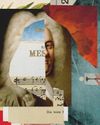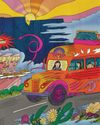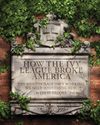
While reading To Paradise, Hanya Yanagihara’s gigantic new novel, I felt the impulse a few times to put down the book and make a chart—the kind of thing you see TV detectives assemble on their living-room walls when they have a web of evidence but no clear theory of the case. To Paradise, which is in fact three linked novels bound in a single volume, is constructed something like a soma cube, with plots that interlock but whose unifying logic and mechanisms are designed to baffle. The first book, “Washington Square,” takes place in the early 1890s in a New York City that the reader quickly realizes is off-kilter. There the prominent Bingham family runs the primary bank of the Free States, one of a patchwork of nations (including the southern Colonies, the Union, the West, and the North) sustaining an uneasy coexistence after the War of Rebellion. In the Free States, homosexuality and gay marriage are perfectly ordinary, but Black people are not welcomed as citizens—the Free States are white, and committed only to giving Black people safe passage to the North and the West. David, the sickly grandson of the Bingham clan, falls in love with a poor musician named Edward, though his grandfather is attempting to arrange his marriage to a steady older man named Charles.
Book 2, “Lipo-Wao-Nahele,” also follows a David Bingham, this time a young Hawaiian man living with his older lover, Charles, in the same house on Washington Square owned by the Binghams in the previous book. David is a descendant of the last monarch of Hawaii, whose legacy is defended by a Hawaiian-independence movement. It is the 1990s, and AIDS is ravaging David and Charles’s world in New York, an erasure of a generation that is counterposed to David’s ambivalent denial of his homeland, his lineage, and his father— who narrates half the book.
This story is from the January - February 2022 edition of The Atlantic.
Start your 7-day Magzter GOLD free trial to access thousands of curated premium stories, and 9,000+ magazines and newspapers.
Already a subscriber ? Sign In
This story is from the January - February 2022 edition of The Atlantic.
Start your 7-day Magzter GOLD free trial to access thousands of curated premium stories, and 9,000+ magazines and newspapers.
Already a subscriber? Sign In

JOE ROGAN IS THE MAINSTREAM MEDIA NOW
What happens when the outsiders seize the microphone?

MARAUDING NATION
In Trumps second term, the U.S. could become a global bully.

THE GENDER WAR IS HERE
What women learned in 2024

The Weirdest Hit in History
How Handel's Messiah became Western music's first classic

ONE FOR THE ROAD
What I ate growing up with the Grateful Dead

HOW THE IVY LEAGUE BROKE AMERICA
THE MERITOCRACY ISN'T WORKING. WE NEED SOMETHING NEW.

Against Type
How Jimmy O Yang became a main character

Catching the Carjackers - On the road with an elite police unit as it combats a crime wave
On August 7, 2022, Shantise Summers arrived home from a night out with friends around 2:40 a.m. As she walked from her car toward her apartment in Oxon Hill, a Maryland neighborhood just southeast of Washington, D.C., she heard footsteps behind her. She turned and saw two men in ski masks. One put a gun to her face; she could feel the metal pressing against her chin. He demanded her phone, wallet, keys, and Apple Watch. She quickly handed them over, and they drove off in her 2019 Honda Accord.

The Most Remote Place in the World - Point Nemo is Earth's official "middle of nowhere." A lot seems to be going on there.
It’s called the “longest-swim problem”: If you had to drop someone at the place in the ocean farthest from any speck of land—the remotest spot on Earth—where would that place be? The answer, proposed only a few decades ago, is a location in the South Pacific with the coordinates 48 52.5291ᤩS 123 23.5116ᤩW: the “oceanic point of inaccessibility,” to use the formal name. It doesn’t get many visitors. But one morning last year, I met several people who had just come from there.

The Elite College Students Who Can't Read Books - To read a book in college, it helps to have read a book in high school.
Nicholas Dames has taught Literature Humanities, Columbia University's required greatbooks course, since 1988. He loves the job, but it has changed. Over the past decade, students have become overwhelmed by the reading, College kids have never read everything they're assigned, of course, but this feels different. Dames's students now seem bewildered by the thought of finishing multiple books a semester. His colleagues have noticed the same problem.